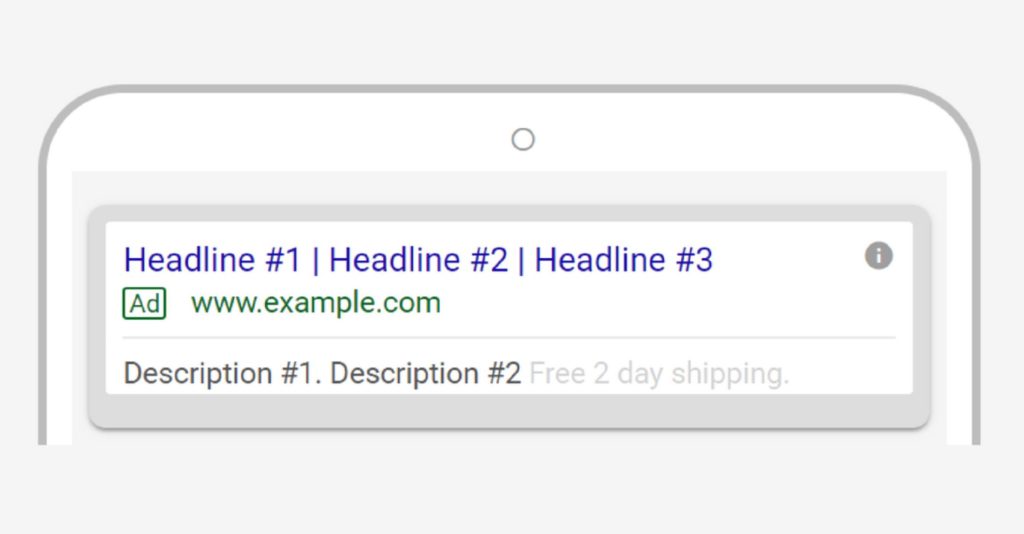As we near the end of the Expanded Text Ads (ETA) era and turn all our Google paid search efforts towards the flagship responsive search ads (RSAs), we have to adapt our copywriting methods for optimal use of what is now the standard ad format in Google Ads.
RSAs differ from their predecessor most notably by the amount of ad copy that they require. With ETAs, an advertiser would write only the amount of ad copy that would appear in each ad, which was 3 headlines and 2 descriptions. With RSAs you can have up to 15 headlines and 4 descriptions included in a single ad. Google Ads algorithms then select the combination of headlines and ad descriptions it expects are most likely to lead to the action you are optimizing for (impression, clicks or leads).
Sounds simple enough, right?
The caveat is that the output on Google’s search engine results page has not changed. In the end, your ad should look like this:

Automation is … Fine
A lot of time and effort has gone into to the enhancement of automation within Google ads. The tools are there to be used, use them. Of course, additional automation means handing some control of your brand’s message to Google. While the idea of giving away control of a brand’s message to automated marketing may make some of us cringe, there are ways to ensure that the message you want out there is held intact.
More Copy is Often Better
When writing your RSA’s Google has a minimum requirement of three headlines and two descriptions. While it may not be necessary to max out with all fifteen headlines, it’s in your best interest to make sure there is a variety in the headlines you are using. Having more ad copy in your ads gives Google the opportunities to show your ads in more search queries. In most cases we recommend including 8-10 (well written!) headlines and four descriptions in each ad.
How to Write Better RSAs
Some other things to keep in mind when writing descriptions and headlines for RSAs include:
Write distinct headlines
Don’t be too concerned with maxing out your character limits. Intent is more important than anything else.
Include call-to-actions
Try to include calls to action (CTA) in some of your headlines and all of your descriptions. Choose CTAs that are consistent with those that appear on your website.
Maintain the tone of your brand throughout all of your ad copy.
Be careful not to fall into the trap of redundant headlines and descriptions.
Ensure that all of your headlines and descriptions make sense when they come together.
Headlines and descriptions should also make sense on their own.
Avoid writing any assets that rely on another being shown next to it.
Highlight your unique selling points in your ad copy.
Whether it’s your price-point, excellent customer service, etc. showcase it!
Pinning in RSAs
One of the only ways to control your brand messaging in RSA’s is to implement a pinning strategy. Pinning allows you to dictate where in a sequence certain headlines and descriptions will appear in an ad.
For each headline in an ad, you can choose to pin it to a specific ad position (the order it appears in the ad). Basically, if you wanted a certain headline to appear only in the first headline spot, you would pin it with the number ‘1’; if you wanted a certain headline to only appear in the second spot, you’d pin it with the number ‘2’… and so on.
Using Pins to Shape your Brand Messaging
Pinning ad assets affords you some ability to shape how your brand message is displayed. The options here are seemingly limitless. You can choose to not pin any headlines or descriptions, letting Google’s machine learning and automation decide what combinations works best. Or you can choose to pin every piece of ad copy you write, or any pinning combination in between. Note that Google recommends not using pinning to achieve optimal results. However, if you have strict brand restrictions, you will need to ignore that advice.
Write Ad Copy with Pinning in Mind
It’s helpful to have an idea of what kind of pinning strategy you might want to use before writing your ad copy, so you can tailor headlines to fit where you want them to. For instance, if you wanted a formula of “Service Headline” | “Branded Headline” | “Unique Selling Point”, you would pin all service-based headlines as 1’s, branded headlines as 2’s… you get the idea. It’s important to remember that a strict pinning strategy limits the variations Google has to work with, and therefore reduces the overall number of headlines or descriptions that can be matched with a potential search query. In some cases, there are strategic reasons for limiting search volume, to avoid unnecessary spending. But there are cases where search volume is already a concern, and further limiting that volume could be detrimental.
Test Your Ad Combinations
If you take nothing else out of this piece, it’s to simply test everything you do. What works in one campaign may not work exactly the same way in another. The only way to understand what works and where is to test your theories, examine the results, and adjust accordingly. And, when results inevitably change, adjust some more!
Let Us Help You
Managing a Google Ads account is an ever-evolving process that requires constant care and attention; RSAs are no exception. In fact, I might go as far as to argue that RSAs require more TLC than their predecessors did.
With more variation brings more opportunities, but it also opens up greater possibility for poorly performing ads and wasted ad spend. Which is why it is imperative, now more than ever, to be monitoring each and every ad group on a consistent basis.
Let us do this for you! We’re here to help our clients optimize their brand’s messaging, even in these days of increased automation.








